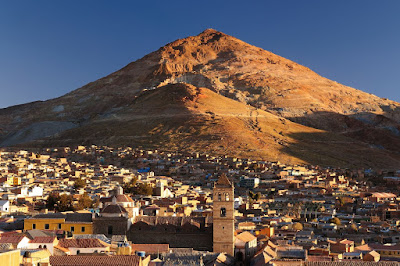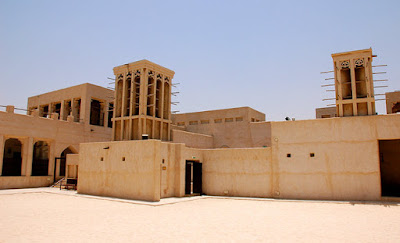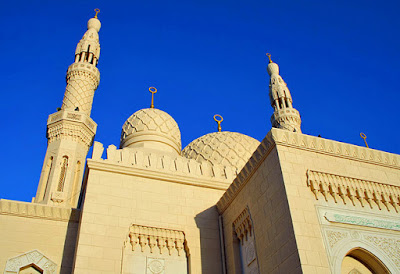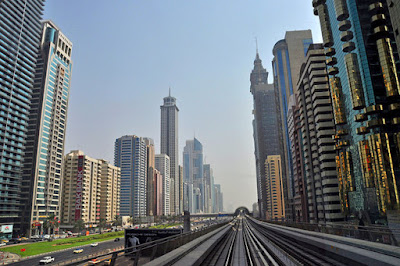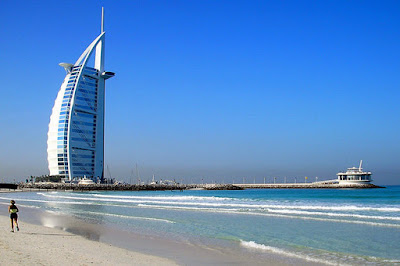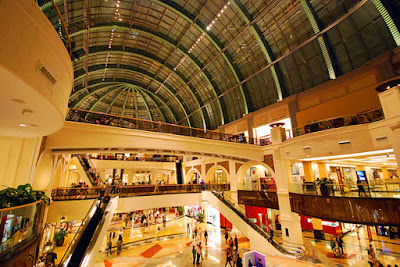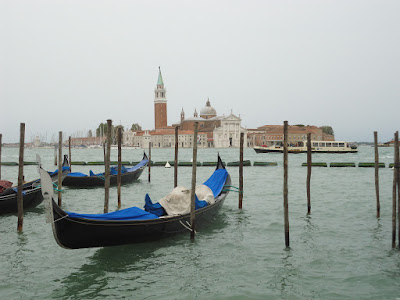Glitzy Dubai is the United Arab
Emirates' vacation hot spot. This city of high-rises and shopping malls has
transformed itself from a desert outpost to a destination du-jour, where people
flock for sales bargains, sunshine and family fun. Dubai is famous for
sightseeing attractions such as the Burj Khalifa (the world's tallest
building) and shopping malls that come complete with mammoth aquariums and
indoor ski slopes.
But this city has many cultural
highlights as well as all the glamorous modern add-ons. Take a wander around
the Bastakia district and you'll discover the Dubai of old, then
cruise along Dubai Creek in a traditional dhow and you'll soon realise
there's more to this city than its flashy veneer.
1 Burj Khalifa:
Dubai's landmark building is the
Burj Khalifa, which at 829.8 m is the tallest building in the world. For
most visitors a trip to the observation deck on the 124th floor here is a
must-do while in the city. The views across the city skyline from this
bird's-eye perspective are simply staggering. The slick observation deck
experience includes a multi-media presentation on both Dubai and the building
of the Burj Khalifa (completed in 2010) before a high-speed elevator whizzes
you up to the observation deck for those 360-degree views out across the
skyscrapers to the desert on one side and the ocean on the other. Night-time
visits are particularly popular with photographers due to Dubai's famous
city-lights panoramas.
Back on the ground, wrapping
around the Burj Khalifa, are the building's beautifully designed gardens with
winding walkways. There are plenty of water features including the Dubai
Fountain, the world's tallest performing fountain, modelled on Las
Vegas' famous Fountains of Bellagio.
2 Dubai Museum:
Dubai's excellent museum is
housed in the Al-Fahidi Fort, built in 1787 to defend Dubai Creek. The fort's
walls are built out of traditional coral-blocks and held together with lime.
The upper floor is supported by wooden poles known as "handels", and
the ceiling is constructed from palm fronts, mud and plaster. In its history,
the fort has served as residence for the ruling family, seat of government,
garrison and prison. Restored in 1971 (and again extensively in 1995) it is now
the city's premier museum. The entrance has a fascinating exhibition of old
maps of the Emirates and Dubai, showing the mammoth expansion that hit the
region after the oil boom.
The courtyard is home to several
traditional boats and a palm-leaf house with an Emirati wind-tower. The right-hand
hall features weaponry and the left-hand hall showcases Emirati musical
instruments. Below the ground floor are display halls with exhibits and
dioramas covering various aspects of traditional Emirati lifestyle (including
pearl fishing and Bedouin desert life) as well as artifacts from the
3,000-4,000 year old graves at Al Qusais archaeological site.
3 Bastakia (Old Dubai):
The Bastakia Quarter was built
in the late 19th century to be the home of wealthy Persian merchants who dealt
mainly in pearls and textiles, and were lured to Dubai because of the tax-free
trading and access to Dubai Creek. Bastakia occupies the eastern portion of Bur
Dubai along the creek and the coral and limestone buildings here, many with
walls topped with wind-towers, have been excellently preserved. Wind-towers
provided the homes here with an early form of air conditioning, with the wind
trapped in the towers funnelled down into the houses. Persian merchants likely
transplanted this architectural element (common in Iranian coastal houses) from
their home country to the Gulf.
Lined with distinct Arabian
architecture, narrow lanes are highly evocative of a bygone, and much slower,
age in Dubai's history. Inside the district you'll find the Majlis Gallery with
its collection of traditional Arab ceramics and furniture (housed in a
wind-tower) and the XVA Gallery with a contemporary art collection (located in
one of the historic buildings).
4 Sheikh Saeed Al-Maktoum House:
Sheikh Saeed Al Maktoum was the
Ruler of Dubai from 1921 to 1958 and grandfather to the current ruler. His
former residence has been rebuilt and restored as a museum that is a fine
example of Arabian architecture. The original house was built in 1896 by Sheikh
Saeed's father, so he could observe shipping activity from the balconies. The
original home was demolished but the current house was rebuilt next to the
original site, staying true to the original model by incorporating carved teak
doors, wooden lattice screens across the windows and gypsum ventilation screens
with floral and geometric designs. Thirty rooms are built around a central
courtyard with wind-tower details on top.
Inside are the exhibits of the Dubai
Museum of Historical Photographs and Documents with many wonderful old
photographs of Dubai from the period between 1948 and 1953. The marine wing of
the museum has photos of fishing, pearling and boat building. Throughout the
building there are many letters, maps, coins and stamps on display showing the
development of the Emirate. Nearby is the Sheikh Obaid bin Thani House,
restored with displays of traditional interiors.
5 Dubai Creek:

Dubai Creek separates the city
into two towns with Deira to the north and Bur Dubai to the south. The creek
has been an influential element in the city's growth, first attracting settlers
here to fish and pearl dive. Small villages grew up alongside the creek as far
back as 4,000 years ago, while the modern era began in the 1830s when the Bani
Yas tribe settled in the area. The Dhow Wharfage is located along Dubai Creek's
bank, north of Al-Maktoum Bridge. Still used by small traders from across the
Gulf, some of the dhows anchored here are well over 100 years old. You can
visit here, watching cargo being loaded and unloaded on and off the dhows. Dhow
workers often invite visitors onto the vessels for a tour, where you can gain
insight into the life of these traditional sailors. Many of the dhows here
travel onwards to Kuwait, Iran, Oman, India, and
down to Africa's horn. This tiny remnant of Dubai's traditional economy is
still a bustling and fascinating place to wander around.
To travel across the creek you
can either take a trip on one of the many dhows that have been restored as
tourist cruise boats or take an abra (small wooden ferry) between the ferry
points on the creek's Bur Dubai and Deira banks.
6 Jumeirah Mosque:
Jumeirah Mosque is considered by
many to be the most beautiful of Dubai's mosques. An exact copy of Cairo's
Al-Azhar Mosque that is eight times its size, the Jumeirah Mosque is a fine
example of Islamic architecture. This stone structure is built in the medieval
Fatimid tradition with two minarets that display the subtle details in the
stonework. It is particularly attractive in the evening when lit with
floodlights. The Sheikh Mohammed Bin Rashid Centre for Cultural Understanding organises
guided tours of the mosque designed to try to foster a better understanding of
the Muslim faith. Tours begin at 10am daily, except Fridays.
7 Deira Souks:
Deira is located on the northern
bank of Dubai Creek and the winding streets here unveil the melting pot of
different nationalities that have come to call Dubai home. On the shore,
ancient dhows load and unload with modern banks, hotels and office buildings
for a backdrop. For travelers Deira is most famous for its traditional souks (markets),
which bustle with shoppers at all times of the day. Deira Gold Souq is
world-renowned as the largest gold bazaar in the world and the reason that
Dubai has received the name "City of Gold". Jewellery of all kinds is
available in a variety of designs from traditional to modern and plenty of
options to customise your own design.
The Deira Spice Souq sells every
imaginable spice with stalls overflowing with bags of frankincense, cumin,
paprika, saffron, sumac and thyme as well as the fragrant oud wood, rose water
and incense. The market was established in the 1830s and features restored
wooden archways and wind-towers. For a much less touristy experience, head to the
fish market where you'll find loads of local action.
8 Sheikh Zayed Road:
Sheikh Zayed Road is the main
thoroughfare running through Dubai's modern downtown business district. This
wide, eight-lane highway is rimmed with towering glass, chrome and steel highrises
along its length. Main attractions are along, or just off, the strip between
the roundabout and the first intersection. The Courtyard Gallery (6A Street)
has an excellent permanent collection focused on contemporary art from Arab
artists. Dubai World Trade Tower (Sheikh Zayed Road) has an observation deck on
its top floor that offers visitors panoramic views.
The Gold and Diamond Park and
Museum (Sheikh Zayed Road) is a one-stop shop for jewellery lovers with 118
manufacturers and 30 retailers all under one roof. The complex's museum
presents the history of Arabic jewellery production and also offers short tours
of the manufacturing plant.
9 Bastakia Mosque:
The Bastakia Mosque may not be
the largest or most glitzy mosque in the United
Arab Emirates but it has to be one of the most photogenic. This lovely
little mosque has exquisite lattice-work detailing made more beautiful by the
blindingly white facade. Nearby you can see the last remnants of Dubai's city
walls, built in the mid-19th century from gypsum and coral.
10 Heritage and Diving Village:
Dubai's architectural, cultural
and maritime heritage is showcased at the Heritage and Diving Village, with
displays related to pearl diving and dhow building - two of old Dubai's
historic economic mainstays. There are also recreations of traditional Bedouin
and coastal village life, with Persian homes, a traditional coffeehouse and a
small souk where potters and weavers practice their handicrafts at the stalls.
Local music and dance are performed from October to April and visitors can get
advice from practitioners of traditional medicine.
11 Dubai Aquarium:
One of the city's top tourist
attractions, the Dubai Aquarium houses 140 species of sea life in the huge
suspended tank on the ground floor of the Dubai Mall. As well as free viewing
from the mall, if you enter the Underwater Zoo you can walk through the
aquarium tunnels.
There are a myriad of activities
where you can get a closer look at the sea life. Glass bottom boat tours (on
top of the tank) are particularly popular. Cage snorkeling and shark diving
activities are also on offer.
12 Dubai Mall:
Dubai Mall is the city's premier
mall and provides entry to the Burj Khalifa as well as the Dubai Aquarium.
There is also an ice-skating rink, gaming zone and cinema complex if you're
looking for more entertainment options. The shopping and eating is endless and
there are nearly always special events such as live music and fashion shows
within the mall. The most famous of these are the annual Dubai Shopping
Festival in January and February and the Dubai Summer Surprises Festival in
July and August.
13 Burj al-Arab:
The Burj Al-Arab is the world's
tallest hotel, standing 321 m high, located on its own artificial island on the
Dubai coastline. Designed to resemble a billowing dhow sail, the exterior of
the Burj Al-Arab is lit up by a choreographed coloured lighting show at night.
Decadent in every way possible, it is one of the most expensive hotels in the
world with the most luxurious suites costing over $15,000 for one night.
For those without unlimited
credit, the way to experience the over-the-top opulence is to go for dinner at
the underwater Al-Mahara restaurant where floor-to-ceiling glass panels in the
dining room walls allow you to view sea life while you eat. Or, book afternoon
tea at the Skyview Bar (a minimum spend is required) on the 27th floor
with its amazing panoramic views of the city.
14 Jumeirah Beach:
This strip of sandy white bliss
is the number one beach destination for Dubai visitors. There are hotels strung
out all along the length, with this being one of the most popular places to
stay for tourists. The beach has excellent facilities with plenty of sun
loungers, restaurants and water-sport operators offering jet skiing.
15 Mall of the Emirates:
Mall of the Emirates is one of
the city's most famous malls with the spectacular (and surreal) Ski Dubai
facility inside. The indoor ski slope is complete with chairlifts and a penguin
enclosure, all at a continuous temperature of -4 degrees Celsius. There's also
a cinema complex and a family entertainment centre with a whole host of rides
aimed at both the big and small. The shopping opportunities are boundless as
are the eating options, offering every conceivable world cuisine.


